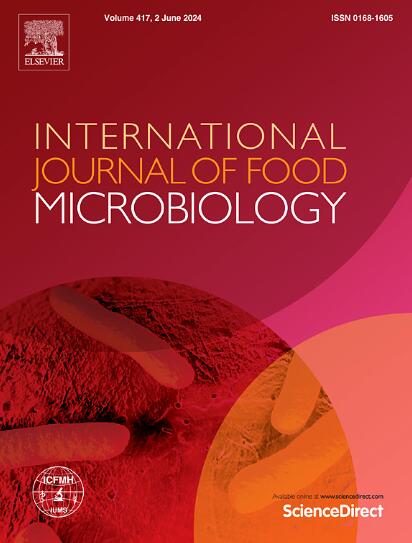met转录组学和HS-GC-IMS揭示了高度保存和容易变质的大豆酱在基因功能、代谢性状和挥发性代谢物方面的差异
IF 5.2
1区 农林科学
Q1 FOOD SCIENCE & TECHNOLOGY
International journal of food microbiology
Pub Date : 2025-06-02
DOI:10.1016/j.ijfoodmicro.2025.111291
引用次数: 0
摘要
传统的发酵大豆酱样品具有高保鲜度和易变质的特点。本研究通过对HP和ES样品的亚转录组学和挥发性代谢物的研究,探讨其对豆酱质量的影响。结果表明,HP大豆酱中以厚壁菌门(Firmicutes)为主,其中芽孢杆菌属(Bacillus)含量最高;ES大豆酱中以变形菌门(Proteobacteria)含量最高,柠檬酸杆菌(Citrobacter)、沙门氏菌(Salmonella)和埃希氏菌(Escherichia)含量最高。氨基酸转运与代谢、碳水化合物转运与代谢、能量产生与转化等基因功能最为丰富。氧化石墨烯功能富集分析显示,HP和ES样品在生物过程、细胞成分和分子功能方面存在显著差异。此外,ABC转运体和氨基酰基trna生物合成是HP样品中显著富集的途径,而ES样品中次生代谢物的生物合成和氯环己烷和氯苯的降解则是通过KEGG途径富集分析发现的。在ES下调基因中,功能相关基因最多的是芽孢杆菌。使用qRT-PCR选择的基因数据有效地验证了亚转录组学结果。对于挥发性化合物,HP含有较多的1-辛烷、1-辛烷-3-醇、乙醇、柠檬烯、乳酸乙酯和乙酸乙酯,ES大豆酱含有较多的丙醛、己醛、3-甲基丁酸和甲醇。本研究为进一步了解影响大豆酱防腐性能的微生物、功能基因和挥发性代谢物提供了依据,有助于提高大豆酱制品的品质。本文章由计算机程序翻译,如有差异,请以英文原文为准。
Metatranscriptomics and HS-GC-IMS unveils the disparities in gene functions, metabolic traits, and volatile metabolites between highly-preserved and easily-spoiled soybean pastes
Traditional fermented soybean paste samples display distinct highly-preserved (HP) and easily-spoiled (ES) characteristics. This study delves into the metatranscriptomic and volatile metabolites investigations of HP and ES samples to explore their influencing on the quality of soybean pastes. The results showed that Firmicutes were predominant in HP soybean pastes, in which genus Bacillus having highest abundance, while Proteobacteria was most abundant in ES ones, with Citrobacter, Salmonella, and Escherichia top abundant. Amino acid transport and metabolism, carbohydrate transport and metabolism, energy production and conversion held most abundant gene functions. HP and ES samples had significant differences in biological processes, cellular components, and molecular functions revealed with GO functional enrichment analysis. Furthermore, ABC transporters and aminoacyl-tRNA biosynthesis were among significantly enriched pathways in HP samples, and biosynthesis of secondary metabolites and chlorocyclohexane and chlorobenzene degradation in ES samples disclosed with pathway enrichment analysis with KEGG. Among ES downregulated genes, the most function-related genes belonged to Bacillus. The selected genes data with qRT-PCR effectively validated the metatranscriptomic results. For volatile compounds, HP had much more 1-octanal, 1-octen-3-ol, ethanol, limonene, ethyl lactate and ethyl acetate, ES soybean pastes had higher levels of propanal, hexanal, 3-methyl butanoic acid, methanol. The research furnishes a comprehension of the microbes, functional genes and volatile metabolites involved in soybean paste preservative properties, which may help improve the quality of soybean paste products.
求助全文
通过发布文献求助,成功后即可免费获取论文全文。
去求助
来源期刊
CiteScore
10.40
自引率
5.60%
发文量
322
审稿时长
65 days
期刊介绍:
The International Journal of Food Microbiology publishes papers dealing with all aspects of food microbiology. Articles must present information that is novel, has high impact and interest, and is of high scientific quality. They should provide scientific or technological advancement in the specific field of interest of the journal and enhance its strong international reputation. Preliminary or confirmatory results as well as contributions not strictly related to food microbiology will not be considered for publication.

 求助内容:
求助内容: 应助结果提醒方式:
应助结果提醒方式:


